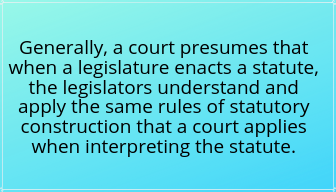Editor’s Note: During the 2019 legislative interim, LegiSource will repost a series of seven articles on statutory construction, which was originally posted over several months from 2013-2016. We are posting the first article this week and will continue posting the articles every other week through October 10. This article was originally posted September 12, 2013.
By Julie Pelegrin
You’ve worked hard to get your bill through both houses and onto the Governor’s desk. You worked with your colleagues on amendments to be sure the bill language clearly and explicitly said just what you intended. Now, the act is signed and on its way to implementation and you can rest easy. Right? Hopefully right. But there may be some people who don’t agree on what this new statute means or on what your carefully crafted language says. Some of these disagreements may be so serious that someone files a lawsuit asking the court to interpret the precise meaning of this new statute. How is the court going to interpret your bill and decide what it means?
This is the first article in a series that looks at statutory construction—how courts approach interpreting a statute and the various rules that they apply. Generally, a court presumes that when a legislature enacts a statute, the legislators understand and apply the same rules of statutory construction that a court applies when interpreting the statute. This series of articles is intended to provide a helpful and informative overview of those rules.
This series of articles is intended to provide a helpful and informative overview of those rules.
We’ll begin the series by looking at one of the basic ground rules a court applies when reading statutes. When someone asks a court to interpret a statute, the first thing the judge does is read the statute. If the statutory language is clear on its face and there is no reasonable doubt as to its meaning, then the judge will simply apply the language of the statute to the case at hand. This is known as the “Plain Meaning Rule.” The judge will decipher the plain meaning of a statute by applying the ordinary, everyday definitions of the statute’s words, unless the statute itself provides specific definitions of the words.
Colorado actually has a statute, section 2-4-101, C.R.S., that supports the Plain Meaning Rule:
Words and phrases shall be read in context and construed according to the rules of grammar and common usage. Words and phrases that have acquired a technical or particular meaning, whether by legislative definition or otherwise, shall be construed accordingly.
In giving the ordinary meaning to words and phrases, the judge will avoid an interpretation that leads to an illogical or absurd result. The judge will also avoid an interpretation that would defeat the obvious intent of the statute.
And as section 2-4-101, C.R.S., requires, the judge will read the statute in context, as a whole and try to give consistent and sensible effect to all parts of the statute. A judge assumes that the General Assembly intended the entire statute to be effective and did not include any statutory language that has no meaning or effect.
Unfortunately the meaning of a statute is not always plain. A judge may find that the language of a statute can be reasonably read to have two or more meanings. Also, a judge may find that there are two or more statutes that apply to a particular situation. The meaning of each statute may be plain, but each statute, as applied, will result in different outcomes. When this happens, the judge will likely find that the statute is ambiguous.
At this point, the judge may turn to the legislative history to try to determine the legislature’s intent when it enacted the statute. In Colorado, the legislative history consists almost entirely of the recorded debates and discussions concerning the bill in the committee of reference and on the floor. The court may also consider the goal that the statute is intended to accomplish, if that is clear from the legislative history or from the statutory legislative intent, and the consequences of a particular interpretation of the statute.
In addition to the legislative history, a judge may apply one or more of the canons, or rules, of statutory construction to interpret a statute. Colorado has codified many rules of statutory construction that we’ll consider in later articles. There are also several widely accepted canons of construction that courts have developed and used to interpret statutes and other legal documents for many years. Subsequent articles will discuss these, as well.
It is important to remember that, if the General Assembly disagrees with a court’s interpretation of a statute, the General Assembly can amend the statute to clarify its intent. But when the court interprets the constitution or finds that a statute violates a constitutional provision, the General Assembly, if it disagrees, can override the court’s opinion only by referring a constitutional measure to the ballot.
